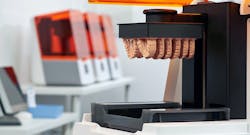Offshoring Runs Its Course As New Balance Brings Jobs Back
For many manufacturers, the ability to accelerate prototyping has become a sweet spot for 3D printing. However, with the right approach, 3D printing is a catalyst for efficiency, arming everyone from production engineers to machine operators with the tools needed to consolidate their supply chains, improve production processes and workflows, and get products to market faster.
Addressing the demands of the experience economy
“As we move toward more on-demand production and mass customization, the future of manufacturing will hinge on companies’ abilities to rapidly produce and tailor the products consumers want when they want them, all while maximizing their own margins,” says Jennifer Milne, Product Manager at Formlabs. “To do this, the factories must adapt their operations to become more streamlined and agile, taking over some previously outsourced processes that elongate production timelines. This may sound like more work, but with the adoption of technologies like 3D printing, manufacturing professionals will be empowered to work smarter, not harder.”
The Formlabs partnership with New Balance is a perfect example. The sneaker industry is constantly evolving to meet the desires of customers, which requires greater design freedom when creating performance-optimizing footwear. “With 3D printing, New Balance has drastically shortened their design-to-manufacturing cycles and completely revamped how they approach the design of their shoes,” she says. “With the launch of its second 3D printed shoe, the FuelCell Echo Triple, just months after the first, New Balance demonstrates how 3D printing can revolutionize the design and production process to shift cycles from months to days or even hours, bringing products to market faster and at a lower cost.”
The bigger picture benefit here is 3D printing’s ability to support cost-effective measures that enable reshoring and localizing production plants because it empowers them to innovate and iterate quickly, explains Milne.
“3D printing can allow companies to react to changes in customer needs in real-time by democratizing manufacturing, reducing the size of the supply chain, improving product line efficiency and slashing lead times significantly,” she says. “We are making it possible to bring New Balance’s shoe manufacturing back to Massachusetts. This means an increased headcount at New Balance’s Lowell, MA plant and a reduction of the company's exposure to international volatility. Having manufacturing close to the customer base also enables the design team to implement necessary changes quickly and in real-time to bring them quality sneakers faster than ever before, shifting production cycles from months to just hours.”
That agility, coupled with proximity to customers through a more distributed manufacturing ecosystem, enables the business to keep a pulse on what users want in a product and react with new and improved offerings faster than ever before. Because this structure allows for a direct line to the consumer and rapid real-time iterations, it also eliminates the need for storage and reduces inventory costs significantly.
Another example of how a combined localized and distributed manufacturing model can result in improved customer satisfaction and business success is the dental industry. With the recent launch of its new dental business unit, Formlabs is supporting dental labs and practices of all sizes by providing a distributed and localized approach to the production of custom dental products like dentures and retainers, surgical guides and crown/bridge models. While scans are done at the dentist’s office, it’s a nearby dental lab that makes the part – and that lab can serve hundreds of dentists. 3D printing locally enables these labs to dramatically shorten lead times and turn around iterations at a lower cost and higher quality.
The opportunity for design freedom is limitless with additive manufacturing, so many organic shapes that only form in nature can be applied to athletic wear for optimal performance. “3D printers and other additive manufacturing tools can help bridge the gap from design intent to manufacturing practicalities to streamline workflows and accelerate and simplify the design processes in a cost-effective manner,” says Milne.
Road ahead
Milne tells IndustryWeek, she sees 3D printing becoming “the driving force behind how everything is made, working behind-the-scenes to create and improve products to meet ever-changing customer needs and demands,” she says. “We can certainly expect more consumer-facing applications as the adoption becomes more widespread, but 3D printing is more than the flashy things it can create; it’s a driver of innovation, efficiency and productivity from the C-suite to the factory floor.”
The reason? One of the most important shifts to take place within the manufacturing industry is that from mass production of thousands of identical parts or products at a low cost per unit, to mass customization, which is already taking place in high-value products such as shoes and dental pieces. “As scanning technology and printing materials advance and hardware prices drop, though, we will see 3D printing as a key driver of the customization of lower-cost consumer goods such as earbuds and sunglasses,” she says. “Because of the technology’s ability to produce very complex parts more quickly and affordably, 3D printing is primed to help manufacturers shift to a scalable mass customization model with ease.”
About the Author
Peter Fretty
Technology Editor
As a highly experienced journalist, Peter Fretty regularly covers advances in manufacturing, information technology, and software. He has written thousands of feature articles, cover stories, and white papers for an assortment of trade journals, business publications, and consumer magazines.


